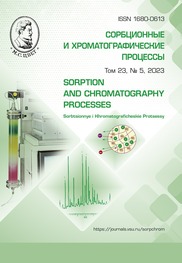The influence of dibutyl sebacate on the sorption properties of a composite superabsorbent based on chitosan
Abstract
Composite superabsorbents, combining both acrylate and biodegradable units, are more environmentally friendly products compared to fully synthetic analogues, however, their equilibrium degree of swelling Qe, usually, lower than the latter. Therefore, the search for new approaches to increase this parameter is an urgent task of modern chemistry. A promising way to solve this problem seems to be the use of plasticizers - low-molecular compounds that increase the segmental and molecular mobility of macromolecules. The purpose of this study was investigation of the effect of the presence of dibutyl sebacate on the sorption properties of composite superabsorbents containing chitosan. Dibutyl sebacate is known as a plasticizer for many industrially important polymers, including cellulose derivatives, and is also less toxic than commonly used phthalates. Superabsorbents based on acrylic acid and acrylamide containing 10 wt.% chitosan with different molecular weights: 20, 200, and 600 kDa were obtained by radical precipitation polymerization with substance initiation. The structure of the resulting superabsorbents was confirmed by FTIR spectroscopy, and the morphology of their surfaces was studied by scanning electron microscopy. With an increase in the molecular weight of the polysaccharide used, a decrease in the equilibrium degree of swelling of the resulting composite superabsorbent in distilled water was observed. In the case of swelling in a 0.15 M NaCl solution, a sharp decrease in Qe values occurred. The presence of dibutyl sebacate increased the equilibrium degree of swelling in distilled water of superabsorbents obtained based on chitosan with molecular weights of 200 and 600 kDa. The increase in Qe values correlated with the molecular weight of the polysaccharide: the higher it was, the more pronounced was the effect of the presence of dibutyl sebacate. A study of the swelling kinetics of superabsorbents showed that, regardless of the presence of dibutyl sebacate, the process is two-stage: a stage of fast and slow water sorption was observed. Using mathematical kinetic models, it was shown that swelling was controlled by chemisorption, and at the slow stage of swelling, the diffusion of water molecules inside the superabsorbent phase played a significant role. Thus, the use of dibutyl sebacate is a promising approach to increasing the equilibrium degree of swelling of composite superabsorbents based on chitosan with a molecular weight of more than 200 kDa.
Downloads
References
Li S., Gang C., Agricultural waste-derived superabsorbent hydrogels: Preparation, performance, and socioeconomic impacts, J. Clean. Prod., 2020; 251: 119669. https://doi.org/10.1016/j.jclepro.2019.119669
Ahmed E.M., Hydrogel: Preparation, characterization, and applications: A review, J. Adv. Res., 2015; 6: 105-121. https://doi.org/10.1016/j.jare.2013.07.006
Ganji F., Farahani S.V., Vasheghani-Farahani E., Theoretical Description of Hydro-gel Swelling: A Review, Iran. Polym. J., 2010; 19: 375-398.
Sorokin A., Lavlinskaya M., Synthesis of the superabsorbents enriched in chitosan derivatives with excellent water absorption properties, Polym. Bull., 2022; 79: 407-427. https://doi.org/10.1007/s00289-020-03521-9
Sorokin A., Sukhanov P., Popov V., Kannykin S., Lavlinskaya M., A new approach to increasing the equilibrium swelling ratio of the composite superabsorbents based on car-boxymethyl cellulose sodium salt, Cellulose, 2022; 29: 159-173. https://doi.org/10.1007/s10570-021-04326-3
Kabiri K., Omidian H., Zohuriaan-Mehr M.J., Novel approach to highly porous superabsorbent hydrogels: synergistic effect of porogens on porosity and swelling rate, Polym. Int. 2003; 52; 1158-1164. https://doi.org/10.1002/pi.1218
Sorokin А.V., Lavlinskaya М.S., Ol-shannikova S.S., Holyavka М.G. Patent RF, № 2778234, 2022. (In Russ.)
Borsagli F.G.L.M., Ciminelli V.S.T., Ladeira C.L., Haas D.J., Lage A.P., Mansur H.S., Multi-functional eco-friendly 3d scaffolds based on n-acyl thiolated chitosan for potential absorption of methyl orange and antibacterial activity against Pseudomonas aeruginosa, J. Env. Chem. Eng., 2019; 7: 103286. https://doi.org/10.1016/j.jece.2019.103286
Revellame E.D., Fortela D.L., Sharp W., Hernandez R., Zappi M.E., Adsorption kinetic modeling using pseudo-first order and pseudo-second order rate laws: A review. Cleaner Eng. Technol., 2020; 100032. https://doi.org/10.1016/j.clet.2020.100032
Ho Y., McKay G., Pseudo-second or-der model for sorption processes, Process Bio-chem. 1999; 34; 451-465. https://doi.org/10.1016/S0032-9592(98)00112-5
Peppas N.A., Khare A.R., Preparation, structure and diffusional behavior of hydrogels in controlled release. Adv. Drug Deliv. Rev., 1993; 11: 1-35. https://doi.org/10.1016/0169-409X(93)90025-Y
Olad A., Zebhi H., Salari D., Mirmohseni A., Reyhanitabar A., A promising porous polymer-nanoclay hydrogel nanocom-posite as water reservoir material: synthesis and kinetic study, J. Porous Mater., 2018; 25: 665-675. https://doi.org/10.1007/s10934-017-0479-x
Ritger P.L., Peppas N.A., A simple equation for description of solute release II. Fickian and anomalous release from swellable devices. J. Control. Release, 1987; 5: 37-42. https://doi.org/10.1016/0168-3659(87)90035-6
Fang S., Wang G., Li P., Xing R., Liu S., Qin Y., Yu H., Chen X., Li K., Synthesis of chitosan derivative graft acrylic acid super-absorbent polymers and its application as water retaining agent, Int. J. Biol. Macromol., 2018; 115: 754-761. https://doi.org/10.1016/j.ijbiomac.2018.04.072
Liu X., Li X., Lu Z., Miao X., Feng Y., Modified acrylic-based superabsorbents with hydrophobic monomers: synthesis, char-acterization and swelling behaviors, J. Polym. Res., 2010; 18: 897-905. https://doi.org/10.1007/s10965-010-9487-0
Arokiaraj R.G., Raju R., Ravikumar S., Sivakumar K., Bhanuprakash P., Pandiyan V., Excess thermodynamic properties and FTIR studies of binary mixtures of aniline with esters at different temperatures, Chem. Data Collect., 2022; 37: 100807. https://doi.org/10.1016/j.cdc.2021.100807
Richbourg N.R., Peppas N.A., The swollen polymer network hypothesis: Quantita-tive models of hydrogel swelling, stiffness, and solute transport, Prog. Polym. Sci., 2020; 105: 101243. https://doi.org/10.1016/j.progpolymsci.2020.101243
Mahon R., Balogun Y., Oluyemi G., Njuguna J., Swelling performance of sodium polyacrylate and poly (acrylamide-co-acrylic acid) potassium salt, SN Appl. Sci. 2020; 2: 17.
Peppas N.A., Brannon-Peppas L., Wa-ter diffusion and sorption in amorphous mac-romolecular systems and foods, J. Food Eng. 1994; 22: 189-210. https://doi.org/10.1016/B978-1-85861-037-5.50015-1
Kim B., Flamme K.L., Peppas N.A., Dynamic swelling behaviour of pH-sensitive anionic hydrogels used for protein delivery, J. Appl. Polym. Sci., 2003; 89: 1606-1613. https://doi.org/10.1002/app.12337







